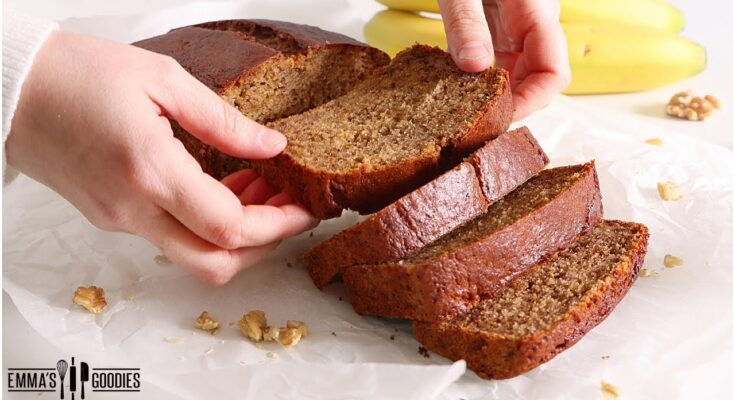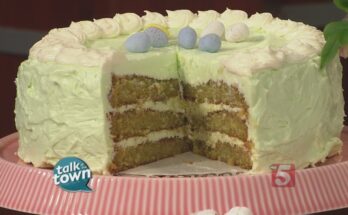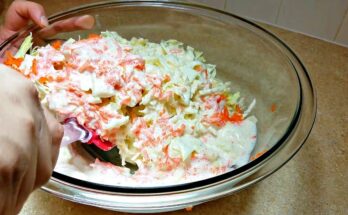Amish Friendship Bread Recipe: Imagine a loaf of bread that’s soft, sweet, and filled with the warmth of tradition—this is Amish Friendship Bread. It’s not your typical loaf of bread; it’s more like a cross between a sweet quick bread and a cake, with a moist, dense texture that melts in your mouth. The most unique aspect? It all starts with a simple fermented starter that you keep feeding and using over time—almost like nurturing a little culinary pet.
At first bite, it feels like comfort food—reminiscent of banana bread or zucchini bread, but richer in tradition and connection. It’s been shared from kitchen to kitchen, neighbor to neighbor, for decades, if not centuries. When someone gives you a bag of the starter and a recipe, they’re not just handing you ingredients—they’re sharing an experience.
Whether you’re a seasoned baker or a beginner, Amish Friendship Bread is a satisfying and meaningful recipe to try. Let’s break it down from the very beginning.
A Brief History of the Bread’s Origins
Though there’s no definitive historical proof of the exact origins, Amish Friendship Bread is believed to have ties to the Amish communities known for their simple, communal way of life. Much like sourdough, it starts with a live yeast culture—a starter—that ferments over time, developing its own unique flavor.
Some stories trace it back to the 1800s, shared among families and friends, which helped keep community ties strong. Others say it gained major popularity in the 1980s as a chain-letter-style baking tradition. You’d receive a starter from a friend with a note and instructions. Ten days later, you’d bake a loaf, keep some starter for yourself, and pass the rest along. It’s literally a gift that keeps on giving.
Why It’s Called “Friendship” Bread
The name isn’t just a charming label—it’s a reflection of how the bread is shared. Once you’ve created a starter, you divide it into portions. Some you keep for yourself, and some you give away along with instructions, creating a ripple effect of baking, connection, and warmth.
It’s a simple act of kindness that’s incredibly wholesome. In today’s fast-paced digital age, it’s rare to see traditions that rely on patience and personal touch. This is one of them. The beauty lies not only in the bread but in the ritual—feeding the starter, watching it grow, and sharing it with others.
Ingredients You’ll Need
Starter Ingredients
To kick things off, you’ll need to prepare the starter. It’s the soul of the recipe—a sweet, bubbly, fermented mix that serves as your base.
Starter Ingredients:
- 1 cup all-purpose flour
- 1 cup granulated sugar
- 1 cup milk (whole or 2% for best results)
- 1 package active dry yeast (optional for quicker fermentation)
Mix these ingredients and let them sit at room temperature. Over the next 10 days, you’ll feed this mixture with more flour, sugar, and milk. This process creates natural yeast and lactic acid bacteria that develop the bread’s signature flavor and texture.
Main Bread Ingredients
Once your starter is ready, it’s time to make the bread. Here’s what you’ll typically need for one batch (which yields two loaves):
Main Ingredients:
- 1 cup Amish Friendship Bread starter
- 2/3 cup vegetable oil
- 3 large eggs
- 1 tsp vanilla extract
- 1 cup granulated sugar
- 1/2 tsp salt
- 1 1/2 tsp baking powder
- 1/2 tsp baking soda
- 2 tsp ground cinnamon
- 2 cups all-purpose flour
- 1 small box (3.4 oz) instant vanilla pudding mix
- 1/2 cup milk
This combination makes a rich, moist bread that’s lightly spiced and incredibly addictive. The vanilla pudding adds a unique softness and sweet flavor that’s hard to beat.
Optional Add-Ins for Custom Flavors
Want to make it your own? The sky’s the limit with add-ins. Popular choices include:
- Chopped nuts (walnuts or pecans)
- Mini chocolate chips
- Fresh or dried fruit (blueberries, apples, raisins)
- Zest of lemon or orange for a citrus twist
- Shredded coconut for tropical flair
Mix and match as you wish, just don’t overload it—about 1 cup total of add-ins per batch is a good rule of thumb.
Step-by-Step Instructions
Step 1 – Making the Amish Friendship Bread Starter
Making the starter is where it all begins. It’s easy but requires a bit of patience. Here’s how you can create your first batch:
Day 1: In a large, non-metal bowl, combine 1 cup each of flour, sugar, and milk. If using dry yeast, dissolve it in a bit of warm water and add it in. Stir until smooth. Cover loosely with plastic wrap and let it sit at room temperature.
Days 2-4: Stir the mixture once daily with a wooden spoon. You might see bubbles—that’s a good sign.
Day 5: Feed the starter with 1 cup flour, 1 cup sugar, and 1 cup milk. Stir to combine.
Days 6-9: Stir the starter once daily. It should become more active, bubbly, and develop a sweet-sour aroma.
Day 10: Feed the starter again with 1 cup flour, 1 cup sugar, and 1 cup milk. Mix well. Now your starter is ready to use!
At this point, you can use one cup to bake, keep one cup for yourself to continue feeding, and gift the remaining cups to friends—each with a printout of the recipe, of course!
Step 2 – Feeding and Maintaining Your Starter
So, your starter is alive and bubbling—now what? Maintaining it is key if you want to keep baking Amish Friendship Bread long term. Think of it as caring for a houseplant; a little attention goes a long way.
Here’s how to feed and maintain your starter weekly:
- Every 5–10 days, feed your starter with:
- 1 cup flour
- 1 cup sugar
- 1 cup milk
Stir well with a wooden or plastic spoon (avoid metal, which can interfere with the fermentation). Let it sit out for a few hours after feeding before storing it again.
Storage Tips:
- Room Temperature: Use if you plan to bake often. Feed every 5 days.
- Refrigerated: If baking occasionally, store it in the fridge. Feed every 7–10 days.
What if I forget to feed it?
No worries—starters are surprisingly forgiving. If it’s only been a couple of days, just feed it again. If there’s mold or it smells rancid instead of tangy-sweet, it’s time to toss it and start fresh.
Keeping your starter active ensures a constant supply of delicious bread and makes it easy to pass on the tradition to others.
Step 3 – Preparing the Bread Batter
Now comes the fun part—turning that bubbly starter into a golden loaf of homemade goodness. Once your starter is ready (usually by Day 10 of the cycle), you can begin baking.
Here’s your step-by-step batter guide:
- Preheat your oven to 325°F (165°C).
- Grease two loaf pans generously. Dust with cinnamon-sugar for a sweet crust.
- In a large bowl, combine:
- 1 cup starter
- 2/3 cup vegetable oil
- 3 large eggs
- 1 tsp vanilla extract
- 1/2 cup milk
- Mix in dry ingredients:
- 1 cup sugar
- 1/2 tsp salt
- 1 1/2 tsp baking powder
- 1/2 tsp baking soda
- 2 tsp ground cinnamon
- 2 cups all-purpose flour
- 1 box vanilla instant pudding mix
- Stir just until combined—don’t overmix!
- Gently fold in any optional add-ins like chocolate chips or fruit.
- Pour batter evenly into the prepared pans.
- Sprinkle the top with a mix of cinnamon and sugar.
Pro tip: Adding a cinnamon-sugar crust on top creates a beautiful golden finish with just the right crunch.
Step 4 – Baking the Bread to Perfection
With everything mixed and poured, it’s time to bake! Amish Friendship Bread doesn’t require any complicated techniques—just a little patience.
Baking instructions:
- Place your pans in the preheated oven.
- Bake for 50 to 60 minutes.
- Check doneness by inserting a toothpick in the center. If it comes out clean, it’s ready!
Cooling tip: Let the bread rest in the pans for 10–15 minutes before transferring to a wire rack. This helps it firm up and prevents it from breaking apart.
Once it’s cooled, slice and serve—or wrap tightly in plastic wrap or foil to keep it moist for days. It even freezes well if you want to enjoy it later!
Storage and Gifting Tips
Amish Friendship Bread is so delightful that you’ll probably want to keep some and give some away. Here’s how to store it properly and package it for sharing.
Storing the Bread:
- Room Temp: Wrap in plastic wrap or foil and store for up to 5 days.
- Refrigerator: Store up to 7 days.
- Freezer: Wrap in foil and place in a freezer-safe bag for up to 3 months.
Storing the Starter:
- In a large resealable plastic bag or a glass jar with a loose-fitting lid.
- Label it with the feeding and baking schedule so you don’t forget.
Gifting the Starter:
- Divide your fed starter into 1-cup portions.
- Pour each into a resealable bag.
- Print out or handwrite the 10-day instructions.
- Add a cheerful label or note to personalize it.
This is what makes it truly “friendship” bread. Whether it’s for a neighbor, coworker, or family member, giving a starter and a loaf is a meaningful gift filled with care—and sugar.
Best Practices for Sharing the Starter
Sharing the Amish Friendship Bread starter isn’t just a culinary gesture—it’s an act of community. When you gift the starter, you’re passing along a little piece of tradition. But to make sure it’s helpful, not confusing, here are some best practices:
- Package Neatly
Use a quart-size resealable bag for each one-cup portion of the starter. Squeeze out excess air before sealing. - Attach Clear Instructions
Include a printed card or handwritten note with:- Feeding schedule (Days 1–10)
- How to make the bread
- Ingredient list
- Reminder to only use non-metal utensils and bowls
- Personal Touches Go a Long Way
Add ribbons, stickers, or your own recipe variation to personalize the gift. You can even include mini loaves of the bread if you’ve already baked a batch. - Encourage the Sharing Spirit
Let your recipients know they’re not expected to bake right away—but if they continue the cycle, they’ll be able to bake again and share more starter in just 10 days. - Digital Sharing
In a more modern twist, you can email the recipe instructions or create a shareable Google Doc. It’s a blend of old-school tradition and new-age convenience.
Sharing isn’t just about food—it’s about giving someone an opportunity to enjoy baking and connect with others. This tradition has survived for generations because it brings people together, one starter bag at a time.
Final Thoughts on Amish Friendship Bread
Why This Recipe Is More Than Just Bread
At first glance, Amish Friendship Bread may seem like just another baked good. But once you dig in—both into the process and the actual loaf—you quickly realize it’s much more.
This isn’t about quick gratification. From feeding the starter to baking and gifting, this bread teaches patience, care, and connection. It’s about slowing down in a world that constantly speeds up. It’s about remembering that food is not just sustenance—it’s memory, tradition, and love.
The baking process itself becomes a small, rewarding ritual. Stirring your starter each day is oddly satisfying. Watching it bubble and grow is like tending a tiny, flavorful ecosystem. And when the aroma of cinnamon and vanilla fills your kitchen—pure magic.
Even more meaningful? Knowing that loaf you just pulled from the oven might inspire someone else to bake, to share, and to keep the tradition alive. You don’t just bake a loaf—you bake joy.
Making the Tradition Your Own
The beauty of Amish Friendship Bread lies in its adaptability. Sure, there’s a traditional method, but you’re free to put your personal spin on it. Here are some ideas to get you started:
- Flavor Swaps
Try using chocolate, lemon, banana, or butterscotch pudding instead of vanilla. Add matcha for a green tea twist or espresso powder for a mocha vibe. - Shape It Differently
Bake in muffin tins for portable breakfast treats or in a bundt pan for a more festive presentation. - Go Healthier
Use whole wheat flour, reduce the sugar, or substitute applesauce for some of the oil. - Start a Family Tradition
Give the starter to your kids, siblings, or parents. Pass it down like a family heirloom—with recipe cards and memories attached. - Host a Friendship Bread Party
Gather a group of friends and share starters, bake together, and trade loaf flavors. It’s a social (and tasty) way to connect.
This recipe invites creativity and connection. So don’t be afraid to break a few rules, try something new, and most importantly—share what you make.
FAQs About Amish Friendship Bread Recipe
What is Amish Friendship Bread?
It’s a sweet, cinnamon-scented quick bread made from a sourdough-like starter passed from friend to friend—hence the “friendship” part. Think banana bread meets sourdough starter, with a sprinkle of nostalgia.
Do I have to use the starter?
Yes, the starter is what gives Amish Friendship Bread its signature flavor and texture. Without it, you’re just baking regular bread (yawn).
How long does the starter last?
If you feed it every 5-10 days, it can last indefinitely! Just keep it in a sealed container in the fridge and treat it like a needy pet.
Can I freeze the starter?
Absolutely. Freeze 1-cup portions in a Ziploc bag and label the date. When you’re ready to bake again, just thaw and feed it like it never left.
What can I make besides bread?
Oh, honey, the possibilities are endless—muffins, pancakes, coffee cake, scones. If it can bake, it can Amish.
Is Amish Friendship Bread actually Amish?
Let’s just say it’s “Amish-inspired.” The origins are a bit murky, but it definitely has that cozy, passed-down-from-Grandma vibe.
Why does the recipe make so much?
Sharing is caring! It’s designed to be gifted. Bake one loaf, give one away, and pass the starter along. Old-school social networking.
Can I make it gluten-free or dairy-free?
Totally. Swap in your favorite GF flour blend or plant-based milk. It’s a forgiving recipe—like a true friend.
Conclusion
Amish Friendship Bread is more than a sweet loaf with a cinnamon crust—it’s a celebration of community, tradition, and the joy of baking. From nurturing your starter to slicing that first warm piece, the process is as rewarding as the final product. Whether you’re sharing it with a neighbor or enjoying it with your morning coffee, this bread brings a piece of history and a lot of heart into your kitchen.
So why not start a new tradition? Make the starter, bake a batch, and pass it along. You never know who might need a little bit of comfort—and cinnamon—in their day.



